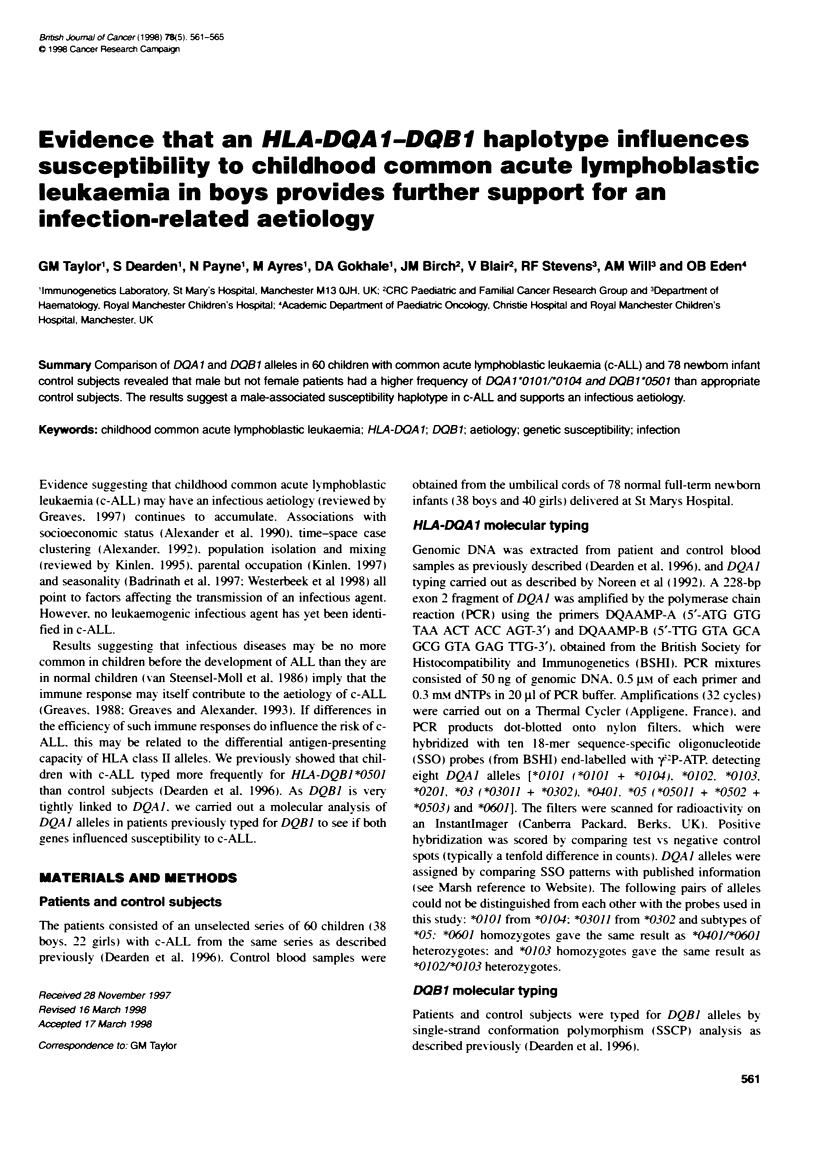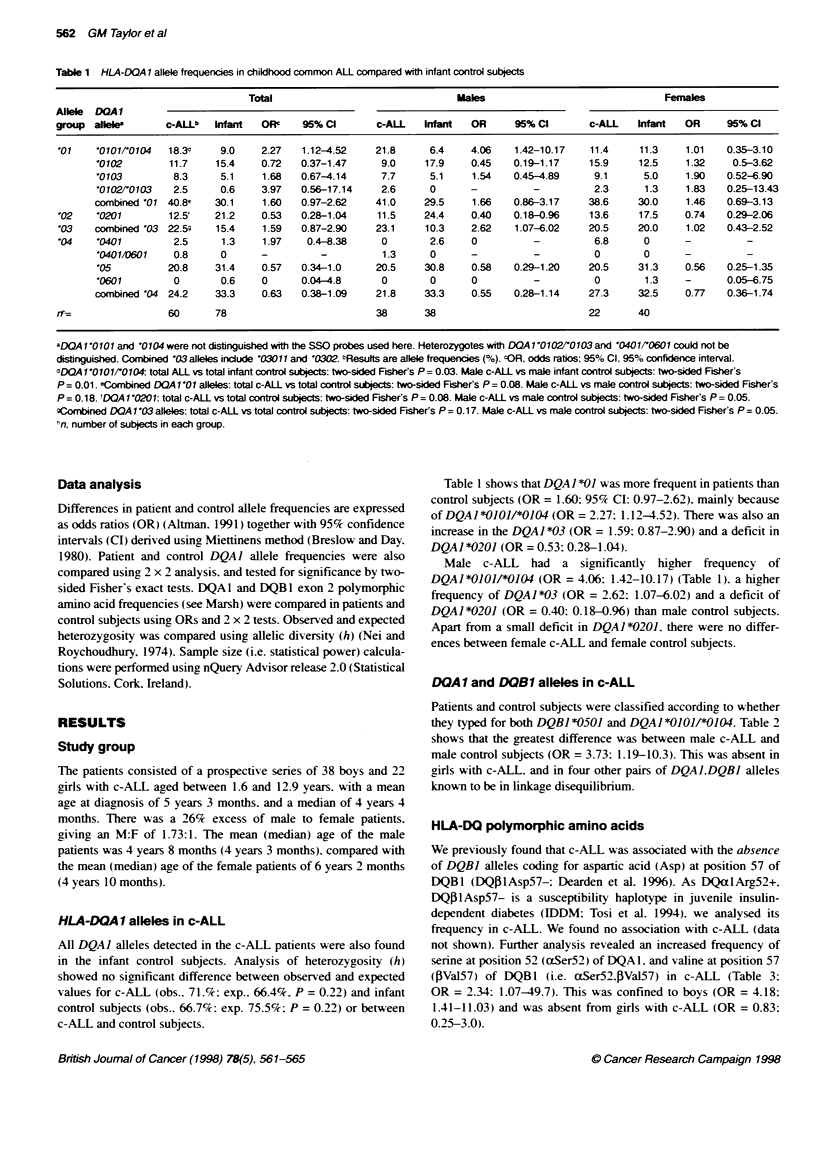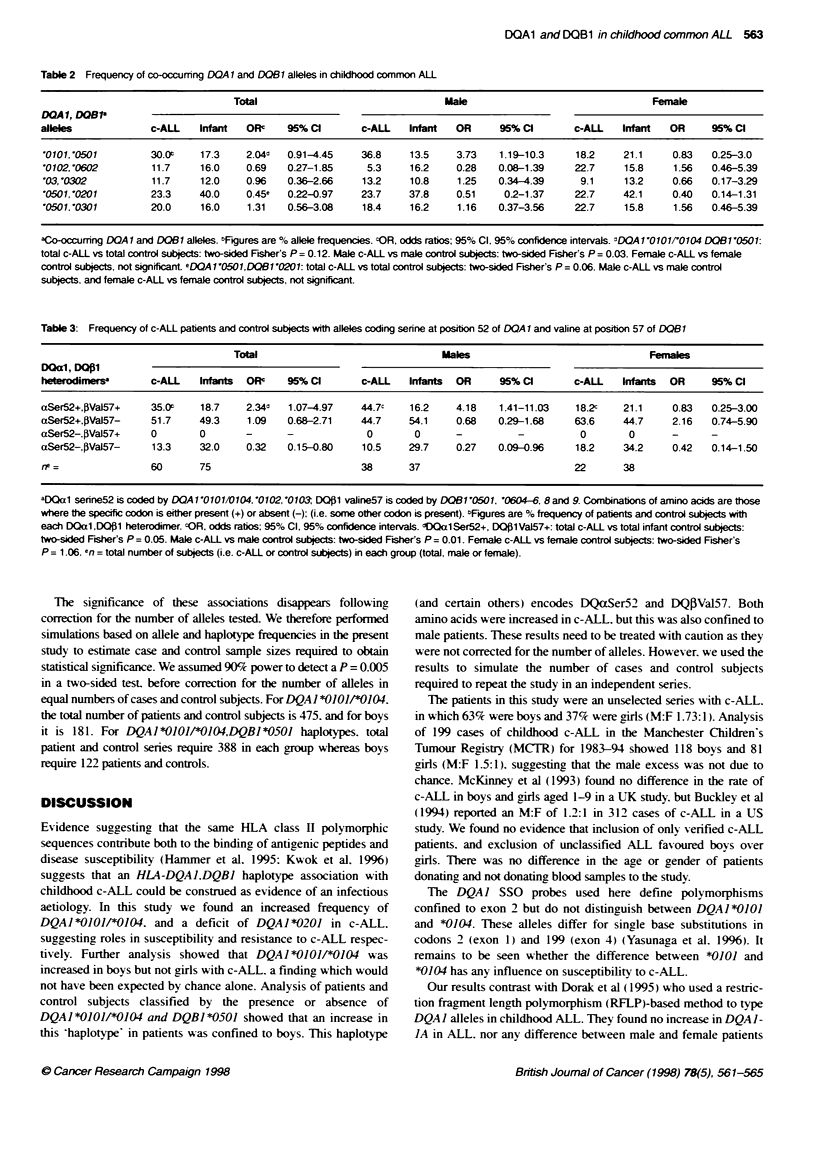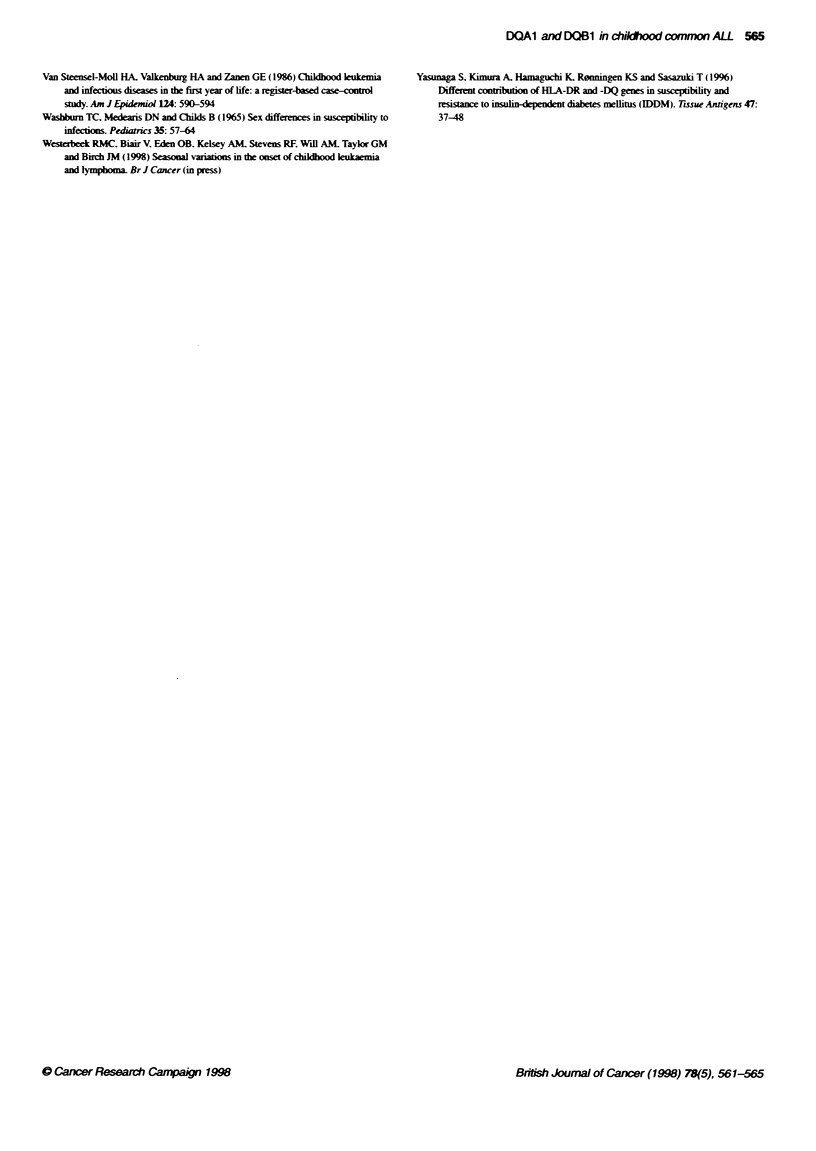Abstract
Comparison of DQA1 and DQB1 alleles in 60 children with common acute lymphoblastic leukaemia (c-ALL) and 78 newborn infant control subjects revealed that male but not female patients had a higher frequency of DQA1*0101/*0104 and DQB1*0501 than appropriate control subjects. The results suggest a male-associated susceptibility haplotype in c-ALL and supports an infectious aetiology.
Full text
PDF




Selected References
These references are in PubMed. This may not be the complete list of references from this article.
- Alexander F. E., Ricketts T. J., McKinney P. A., Cartwright R. A. Community lifestyle characteristics and risk of acute lymphoblastic leukaemia in children. Lancet. 1990 Dec 15;336(8729):1461–1465. doi: 10.1016/0140-6736(90)93176-p. [DOI] [PubMed] [Google Scholar]
- Alexander F. E. Space-time clustering of childhood acute lymphoblastic leukaemia: indirect evidence for a transmissible agent. Br J Cancer. 1992 Apr;65(4):589–592. doi: 10.1038/bjc.1992.119. [DOI] [PMC free article] [PubMed] [Google Scholar]
- Badrinath P., Day N. E., Stockton D. Seasonality in the diagnosis of acute lymphocytic leukaemia. Br J Cancer. 1997;75(11):1711–1713. doi: 10.1038/bjc.1997.292. [DOI] [PMC free article] [PubMed] [Google Scholar]
- Buckley J. D., Buckley C. M., Ruccione K., Sather H. N., Waskerwitz M. J., Woods W. G., Robison L. L. Epidemiological characteristics of childhood acute lymphocytic leukemia. Analysis by immunophenotype. The Childrens Cancer Group. Leukemia. 1994 May;8(5):856–864. [PubMed] [Google Scholar]
- Dearden S. P., Taylor G. M., Gokhale D. A., Robinson M. D., Thompson W., Ollier W., Binchy A., Birch J. M., Stevens R. F., Carr T. Molecular analysis of HLA-DQB1 alleles in childhood common acute lymphoblastic leukaemia. Br J Cancer. 1996 Mar;73(5):603–609. doi: 10.1038/bjc.1996.104. [DOI] [PMC free article] [PubMed] [Google Scholar]
- Doherty D. G., Vaughan R. W., Donaldson P. T., Mowat A. P. HLA DQA, DQB, and DRB genotyping by oligonucleotide analysis: distribution of alleles and haplotypes in British caucasoids. Hum Immunol. 1992 May;34(1):53–63. doi: 10.1016/0198-8859(92)90085-2. [DOI] [PubMed] [Google Scholar]
- Dorak M. T., Owen G., Galbraith I., Henderson N., Webb D., Mills K. I., Darke C., Burnett A. K. Nature of HLA-associated predisposition to childhood acute lymphoblastic leukemia. Leukemia. 1995 May;9(5):875–878. [PubMed] [Google Scholar]
- Greaves M. F. Aetiology of acute leukaemia. Lancet. 1997 Feb 1;349(9048):344–349. doi: 10.1016/s0140-6736(96)09412-3. [DOI] [PubMed] [Google Scholar]
- Greaves M. F., Alexander F. E. An infectious etiology for common acute lymphoblastic leukemia in childhood? Leukemia. 1993 Mar;7(3):349–360. [PubMed] [Google Scholar]
- Greaves M. F. Speculations on the cause of childhood acute lymphoblastic leukemia. Leukemia. 1988 Feb;2(2):120–125. [PubMed] [Google Scholar]
- Kinlen L. J. Epidemiological evidence for an infective basis in childhood leukaemia. Br J Cancer. 1995 Jan;71(1):1–5. doi: 10.1038/bjc.1995.1. [DOI] [PMC free article] [PubMed] [Google Scholar]
- Kinlen L. J. High-contact paternal occupations, infection and childhood leukaemia: five studies of unusual population-mixing of adults. Br J Cancer. 1997;76(12):1539–1545. doi: 10.1038/bjc.1997.592. [DOI] [PMC free article] [PubMed] [Google Scholar]
- Kwok W. W., Kovats S., Thurtle P., Nepom G. T. HLA-DQ allelic polymorphisms constrain patterns of class II heterodimer formation. J Immunol. 1993 Mar 15;150(6):2263–2272. [PubMed] [Google Scholar]
- McKinney P. A., Alexander F. E., Cartwright R. A., Scott C. S., Staines A. Acute lymphoblastic leukaemia incidence in the UK by immunophenotype. Leukemia. 1993 Oct;7(10):1630–1634. [PubMed] [Google Scholar]
- Nei M., Roychoudhury A. K. Sampling variances of heterozygosity and genetic distance. Genetics. 1974 Feb;76(2):379–390. doi: 10.1093/genetics/76.2.379. [DOI] [PMC free article] [PubMed] [Google Scholar]
- Tosi G., Brunelli S., Mantero G., Magalini A. R., Soffiati M., Pinelli L., Tridente G., Accolla R. S. The complex interplay of the DQB1 and DQA1 loci in the generation of the susceptible and protective phenotype for insulin-dependent diabetes mellitus. Mol Immunol. 1994 Apr;31(6):429–437. doi: 10.1016/0161-5890(94)90062-0. [DOI] [PubMed] [Google Scholar]
- WASHBURN T. C., MEDEARIS D. N., Jr, CHILDS B. SEX DIFFERENCES IN SUSCEPTIBILITY TO INFECTIONS. Pediatrics. 1965 Jan;35:57–64. [PubMed] [Google Scholar]
- Yasunaga S., Kimura A., Hamaguchi K., Ronningen K. S., Sasazuki T. Different contribution of HLA-DR and -DQ genes in susceptibility and resistance to insulin-dependent diabetes mellitus (IDDM). Tissue Antigens. 1996 Jan;47(1):37–48. doi: 10.1111/j.1399-0039.1996.tb02512.x. [DOI] [PubMed] [Google Scholar]
- van Steensel-Moll H. A., Valkenburg H. A., van Zanen G. E. Childhood leukemia and infectious diseases in the first year of life: a register-based case-control study. Am J Epidemiol. 1986 Oct;124(4):590–594. doi: 10.1093/oxfordjournals.aje.a114431. [DOI] [PubMed] [Google Scholar]


